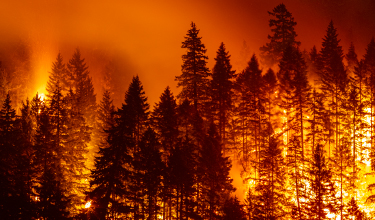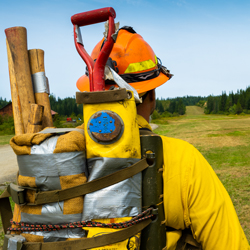
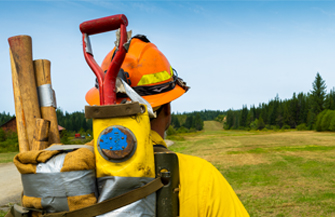
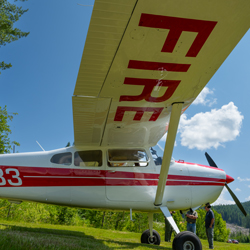
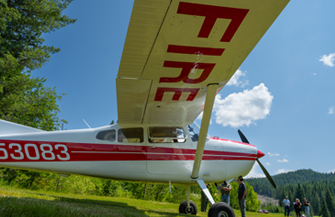
Mitigating Wildfire Risk
Wildfires can occur because of lightning or human causes. While human causes are the source of over 87% of total fires, lightning accounts for over 54% of total acres burned. The U.S. West has seen an increase in fire size and frequency, driven by drought, high levels of federal or non-working forest ownership, and more remote acreage. In the U.S. South, weather, ownership, and access typically enable a more effective wildfire response. As climate change risks further increases in wildfire, mitigation measures and coordination across ownerships become increasingly important. Wildfire behavior can be influenced by weather, amount of readily combustible fuels, lack of moisture, and topography, and when the conditions are right, can increase fire severity and damage to the environment. The strongest mitigation tool for wildfire risk is to reduce the amount of fuel that is readily available in the understory, midstory, and overstory through thinning, prescribed fire, maintained fuel breaks, and strategically placed landscape-level fuels treatments. These timberland management treatments have also been proven to improve forest health and biodiversity benefits. In addition, a forest with age-class diversity changes the fuels and provides natural landscape breaks through younger stands.
Unmanaged lands typically have overstocked forests that provide significant ladder fuels, increasing the threat of crown fires. Ladder fuels provide continuous vertical fuels for the fire to climb from the forest floor to the canopy and become a crown fire. Insect and disease damage is also more prevalent in overcrowded forests, increasing readily combustible fuels. Crown fires are extremely challenging to stop using direct firefighting efforts and control is often accomplished through breaking fuel availability in the predicated path of the fire. This can mean the difference between a fire burning tens of thousands of acres in unmanaged timberlands, compared to hundreds of acres in managed or working timberland. Efforts are underway to improve the forest health in unmanaged lands. Good Neighbor Authority enables federal land managers to enter into agreements with state governments to implement projects focused around restoring or improving overall forest health through treatments that target reducing hazardous fuels. Idaho Shared Stewardship establishes a policy for shared management by federal land managers with states, tribes, and other landowners to manage fire rick through a set of shared priorities. In addition, it calls for coordination among federal, state, tribal and local assets for wildfire prevention, suppression, and post-wildfire restoration, and for action to be taken to remove hazardous fuels and increase active management. Working forest owners are also engaging in policy solutions to review and update federal wildfire suppression with an eye toward improving interagency coordination and alignment around wildfire suppression, including decisions about initial attack, fire management, and the use of specific firefighting strategies.
In Idaho, we have implemented heightened measures to prevent fires, minimize damage from fires and to protect our timberlands from loss. In 2021, approximately 1,000 acres of our timberlands in Idaho and 500 acres in the U.S. South were impacted by wildfire. Overall, the state of Idaho had 1,332 fires in 2021 which impacted 439,660 acres of public and private land. In our four southern states of Alabama, Arkansas, Louisiana, and Mississippi, there were a total of 2,847 fires that burned a combined 70,398 acres.


Mitigating Insect Disease Risk
We minimize insect and disease risks by actively managing forests to maintain their health and vigor. Vigorous stands of trees are resilient to attacks – virtually every major forest health epidemic has been caused by large extents of forests that were in poor health because of being overstocked and/or decadent.
Forest vigor and resilience is maintained through planning and implementation of forest management activities which include planting locally adapted species that are selectively bred to thrive in the location – they are planted, judiciously controlling stocking density to ensure full site occupancy without becoming overstocked, maintaining optimum stocking levels as trees grow, controlling competing vegetation, utilizing harvest patterns to avoid large extents of single age classes, and actively monitoring insect, disease, and animal damage levels. Maintaining forest health through preventive measures is by far the most practical strategy to minimize losses from insects and disease and it is uncommon for us to need to use insecticides, fungicides or other direct insect and disease control measures.
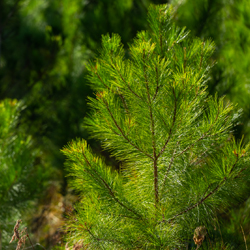
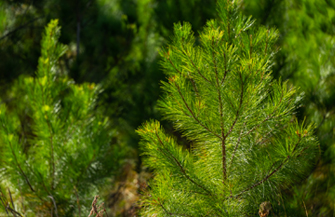
Mitigating Storm Damage Risk
When Hurricane Helene made landfall in September 2024, it delivered a sharp reminder of the increasing risks that extreme weather poses to working forests. The storm caused an estimated $1.28 billion in timber losses across the State of Georgia. “Hurricane Helene was a historic storm that created generational losses for Georgia’s landowners,” said Georgia Forestry Commission Director Johnny Sabo. PotlatchDeltic's timberlands experienced limited damage, approximately 2,000 acres. The company’s disciplined forest management practices and rapid response efforts minimized operational and financial impact.
PotlatchDeltic’s risk mitigation strategy begins long before storms reach the radar. In hurricane-prone regions, foresters apply silvicultural techniques that minimize risk exposure. This includes optimizing stand density, maintaining age class diversity, and staggering harvest rotations to reduce vulnerability to windthrow (i.e., the uprooting of trees caused by wind). Infrastructure investments to maintain access roads and drainage systems are key to allowing crews to respond quickly in the aftermath of extreme weather.
Immediately after Hurricane Helene passed, PotlatchDeltic crews launched salvage operations to recover merchantable timber before market viability declined, typically within a six-month window. Within days, equipment was mobilized to affected areas. Removing damaged wood promptly not only reduces economic loss but also can help prevent outbreaks of bark beetles and other pests that thrive in storm-damaged forests.
Safety is central to every recovery operation. After Hurricane Helene, crews worked in difficult conditions: downed power lines, blocked roads, and limited cell service. All personnel were equipped with the appropriate personal protective equipment and stayed in constant communication during salvage operations. Looking ahead, all impacted acres have been scheduled for replanting in late 2025. Site preparation is already underway to promote optimal growing conditions.
PotlatchDeltic’s response to Hurricane Helene demonstrates how proactive forest management, rapid salvage operations, and sustainable reforestation work together to reduce storm risk. As climate events become more frequent and intense, building resilient forests will be essential to safeguarding both ecosystems and economic value.


